- Short-term
Action Plan for GOI/States. Rivers Ravi, Sutlej and Beas are allocated to India
under IWT? Is India fully utilising these river waters? Has India created this
storage of 3.6 MAF on rivers Jhelum, Chenab, Indus? What are key provisions of
IWT? Is IWT unfair to India? What is the impact
of suspending IWT? China/Afghanistan angles.
Ever
since India put the Indus Water Treaty (IWT) in abeyance it is in the news.
This
article seeks to present a complex subject in a simple way and stresses what
India should first utilise waters of Ravi, Sutlej and Beas.
Short to Medium term Action Plan for Government of India
Harike
(near Amritsar) is the Sangam of rivers Sutlej and Beas that flow from
Himachal. From there one line of water flows towards Ferozepur (Indian Punjab)
and thereafter to Pakistan. Another line is to Rajasthan through the Indira
Gandhi Canal while the Gang canal is fed from
Sutlej river near Ferozepur. SO -
To
reduce or stop water from flowing from Ferozepur into Pakistan the water from
Harike can be directed towards India. Three ways. One, desilting and repair
(includes lining to reduce seepage) of existing Punjab canals increases their
carrying capacity. Two, increasing the carrying capacity of canals that take
water to Rajasthan. Three, build new canals to take water to Punjab.
This
should be a Central Government funded project implemented in mission mode.
Labour should preferably be from Punjab and Rajasthan. The team should
simultaneously work with the state government, Bhakra Beas Management Board and
Punjab farmers to identify new canals that can carry water from Harike to other
parts of Punjab. This could partially restore falling ground water levels and
generate employment, contribute to GDP growth.
The
project should be headed by someone of the calibre of former GOC XV Corps Lt
Gen Tiny Dhillion (retd), currently Chairman Board of Governors IIT Mandi.
Objective 1 is to
ensure as little water from Ravi, Sutlej, Beas goes to Pakistan. Simultaneously
prepare a plan to created storage capacity of 3.6 MAF and maximise hydro power
production on rivers Jhelum, Chenab and Indus. Read on.
1. Treaty signed in 1960 and covers six rivers
Overview of source
and flow of 6 rivers. Table 1 explains
|
Rivers
|
Source
|
Flow
thru
|
Major
Dam India
|
|
To India
|
|
|
|
|
Ravi
|
Himachal
|
Himachal,
Punjab, Pakistan
|
Thein
Dam, Shahpur Kandi
|
|
Sutlej
|
Tibet
|
Himachal.
Pakistan. Note 1
|
Bhakra
Dam
|
|
Beas
|
Himachal
|
Himachal,
Punjab
|
Pong
Dam
|
|
To Pakistan
|
|
|
|
|
Indus
|
Tibet
|
Ladakh,
Skardu, Gilgit, Arabian Sea
|
|
|
Jhelum
|
Valley
|
Valley
|
Wullar
Barrage, Kishenganga hydroelectric, Uri
|
|
Chenab
|
Himachal
|
Jhelum
joins
Chenab
at Trimmu in Pakistan.
|
Salal
Dam, Baglihar hydro, Dulhasti
|
 Map showing river flow.
Map showing river flow.
I
am unable to share the status of each dam project. Have put name against river
for easy identification. It is key to understand the source and flow of each
river.
Note 1 Sutlej – “After entering the plain at Rupnagar (Ropar), it turns westwards and is joined by the Beas at Harike (wetland near Amritsar). From near Ferozepur to Fazilka in Punjab it forms the boundary between India and Pakistan for nearly 120 km.” Source
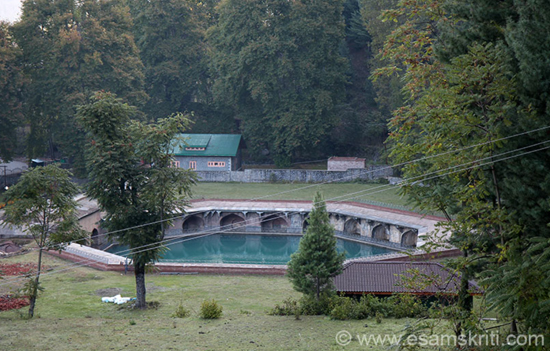 Verinag in Kashmir is the source of the river Jhelum.
Verinag in Kashmir is the source of the river Jhelum.
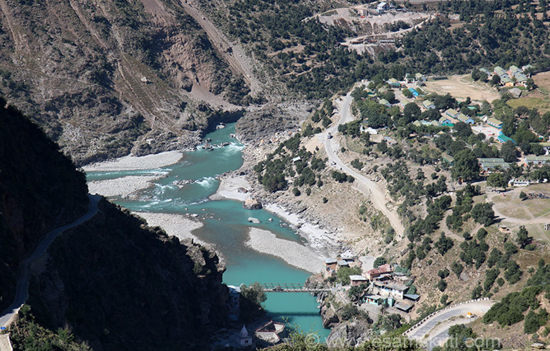 On right you see river Chenab flowing and from below is Paddar river. Where they join is Bhandarkut Sangam. Pic close to Kishtwar in Jammu region. 2014
On right you see river Chenab flowing and from below is Paddar river. Where they join is Bhandarkut Sangam. Pic close to Kishtwar in Jammu region. 2014
Have
seen the origin of Beas at Rohtang Pass. In 1988 did not have a camera.
It is not known to me if waters from
Harike directly flow into Pakistan. Local sources say that when water flows
from Ferozepur to Pakistan and if the latter do not want the water they do not
open the gates at their head works means the water bounces back to India.
It is worth mentioning that from Harike
there is a feeder canal that takes the water to the Indira Gandhi
Canal in Rajasthan
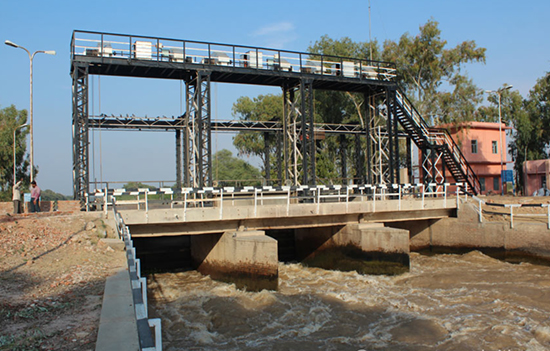 Indira Gandhi Canal near Bikaner. 2014.
Indira Gandhi Canal near Bikaner. 2014. Till 1809 the Indus ended at Lakhpat in Kutch, Gujarat from it entered into the Arabian Sea. An earthquake changed that. Guru Nanak went to Medina from
Lakhpat.
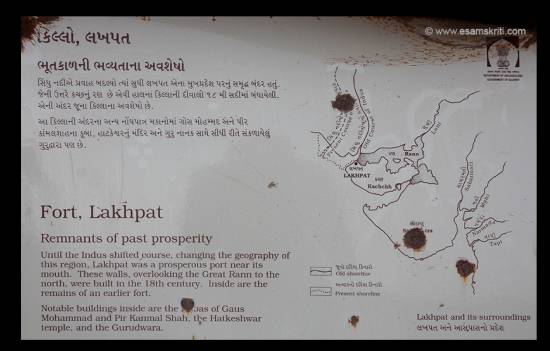
From the above
waters of rivers Ravi and Sutlej are flowing into Pakistan inspite of India
having full rights to those waters. Ravi enters Punjab near Pathankot
district while Sutlej enters Pakistan from
Fazilka. Brig Mishra later responds to media reports stating that with Shahpur Kandi
barrage flow of Ravi to Pakistan has stopped.
Vijay Mohan wrote in Tribune Chandigarh that app 2 Million Acre Feet of eastern rivers
flowed into Pakistan. It was mostly rain or monsoon excess that was beyond the
holding capacity of these rivers and canals and released through the Ferozepur
barrage.
Brig
P K Mishra (retd) wrote in the Week in January 2025, “It has been reported in some print media that with the completion of Shahpur Kandi Dam, India will completely prevent the flow of Ravi water into Pakistan. However, that is unlikely to happen since, in addition to the flood water released downstream of Madhopur Headwork (Punjab) in Ravi River, an additional 5.611 billion m3 of water in an average year is available in its downstream where the river travels for a further 80 km, up to Ravi Siphon, its final crossing point into Pakistan.” 8
Government of India must tell if the flow of Ravi waters to Pakistan
has stopped?
In Pakistan Sutlej “receives the collective drainage of the Ravi, Chenab and Jhelum rivers. It joins the Indus a few kilometres above Mithankot in Pakistan.”
2. Key provisions of the Indus Water Treaty
Eastern
rivers are Ravi, Sutlej, Beas and Western rivers (Indus system) are Indus,
Jhelum, Chenab. Lt Gen Pramod Grover wrote in Tribune Chandigarh –
1.“IWT allocates the water of the three western rivers to Pakistan, but allows India to tap the considerable hydropower potential before the rivers enter Pakistan.”
Thus, India can
make more power projects on Jhelum and Chenab both of which originate in UT of
Jammu and Kashmir and meet the demands of Indian UT.
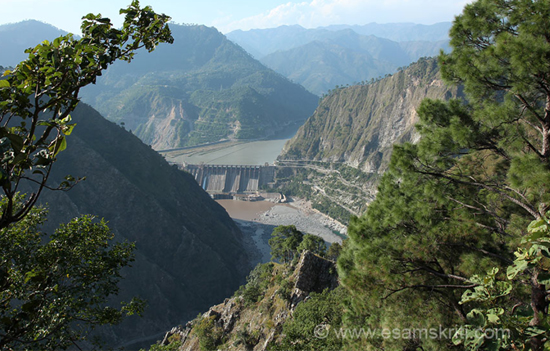 Salal Dam on
Chenab river, near Jammu in UT of J&K. 2014.
Salal Dam on
Chenab river, near Jammu in UT of J&K. 2014.
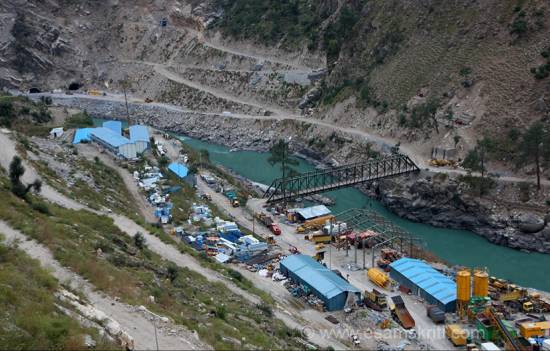 Ratle Dam on river Chenab near Kishtwar in Jammu region. 2014.
Ratle Dam on river Chenab near Kishtwar in Jammu region. 2014.
2. “IWT allowed India to create storage on the western rivers of 1.25, 1.60, and 0.75 MAF (million acre feet) for general, power, and flood storages, respectively, amounting to total permissible storage of 3.6 MAF.” And irrigate 1.3 million acres of land. Source
Has India created storage for 3.6 MAF or is water going to Pakistan?
3. “IWT does not require India to deliver assured quantities of water to Pakistan and instead it requires India to let flow to Pakistan the water available in these rivers excluding the limited use permitted to India by the treaty.”
Is there any
mechanism for Pakistan to measure the water it has received?
4. “There are no quantitative limits to the hydroelectricity that India can produce using the western rivers nor any limit to the number of run-of-the-river projects India can build.”
Lt Gen Grover also wrote, “Of the 1.34 million acres permitted for irrigation, India is using only 0.792 million acres. Out of an assessed potential of 18,653 MW, only projects worth 3,264 MW have been commissioned so far.”
India must first utilize its share of water allocated from eastern rivers, both as power and hydropower.
If such utilization results in lower flows to Pakistan, so be
it. India is well within its rights to do so.
A
Parliamentary Committee report in Tribune Chandigarh (July 2022) says
storage capacity needs to be created.
3. What was the background in which India signed the IWT in
1960?
Maj General Ajay K Chaturvedi (Retd) wrote in a
paper published by the Vivekananda International
Foundation, “At the time of Partition water sharing between India and Pakistan could not be arrived at because of a peculiar situation wherein two of the major Head works, namely Ferozpur and Madhopur Head Works, were in India and canal system was in Pakistan.” 17
Negotiations
continued based on the World Bank proposals for next six years.
Mridula Ramesh
wrote
in Hindustan Times, “India needed World Bank assistance to resolve its balance of payment crisis in 1956. Help came with strings attached. The World Bank president convinced India to sign IWT. India has to pay $ 174 million towards projects that helped Pakistan bypass Indian head works while supplying it with water while these projects were built.”
Further,
India must have good relations with Nepal and Bhutan through tourism and
hydropower agreements. These countries along with Sikkim and Arunachal are
important from a hydropower-geopolitical perspective wrote Mridula.
4. Is IWT fair to India?
“India gave away 80.52 per cent of the Indus system waters to Pakistan.” Wonder what India got in return! Wars 1965, 1971, 1999, terrorism and a very significant reduction in Hindu population in modern day Pakistan.
Geostrategist Brahma Chellaney wrote, “IWT compels the upstream nation (India) to forego major river uses for the benefit of the downstream state.” Source Rework
the terms of the Indus Water Treaty
Rahul
Bhandari wrote in Hindustan Times, “India would have been qualified for at least 42.8% share of the waters of the Indus basin based on the criteria of population, drainage area and state of cultivated lands.”
“The Treaty has too many engineering provisions, which give Pakistan undue
advantage to vet the designs of the Indian projects on Western Rivers.” 17
“India needs to flag the issue to highlight the conduct of Pakistan in not getting design concurrence for its Left Bank Outfall Drain (LBOD); this Drain passes through the Great Rann of Kutch, over areas adjacent to India’s Kutch, and causes floods besides contaminating water bodies on Indian side, in violation of the Article VI and Article IX of IWT.” 17
IWT treats J&K unfairly. “No wonder, in 2003 the J&K Assembly passed a resolution to review the IWT.” 17
5. What is the impact of suspending the IWT?
“The suspension means India can stop sharing crucial information and data on release of water from barrages/dams or on flooding.” Tribune
Chandigarh
H
Sharma wrote in the Indian
Express,
“There will be no design or operational restrictions on India for the use of the water of the Indus and its tributaries.
India can now create storage on the Western Rivers, Indus, Jhelum and Chenab,” P K Saxena, former Indian Commissioner for Indus Waters.
India
can also stop visits by Pakistani officials to the two hydroelectric projects
currently under construction in Jammu & Kashmir — the Kishenganga HEP on Kishenganga, a tributary of the Jhelum, and the Ratle HEP on the Chenab — Saxena said.
“India can undertake reservoir flushing (a technique used to remove accumulated sediment from reservoirs by releasing water through low-level outlets to scour out the sediment and transport it downstream) on the Kishenganga project, which will increase the life of the dam,” he said.”
“Under the Treaty, the waters of Eastern Rivers were allocated to India. Pakistan for agricultural purposes could withdraw from certain tributaries of Ravi, located downstream of Madhopur Head Works, a total of 45400 acres of water (Article II of the Treaty.” 17 India will no longer need to
comply with this clause.
6. China concerns
Some are concerned that given the China Pakistan nexus any attempt to divert waters might result in China reducing flows from Tibet into Sutlej and Indus. China is no friend of India. Reports indicate that the Chinese are already constructing storage/dams on these rivers before they enter India and “we have already experienced the Chinese-triggered Pare-chu (Sutlej) deluge in 2000 and the Brahmaputra floods in 2020.” Size of the Indian market might make China think again before flooding India.
Lt Gen KJ
Singh retired wrote in Tribune
Chandigarh, “The relevant facts are: first, regarding the Brahmaputra (Tsangpo), 40-50% of the water originates from Tibet, and 70% flows to Bangladesh after accumulating in India. Therefore, the maximum impact would be on Bangladesh, especially during the lean season for flushing requirements.”
7. Afghanistan Angle
“The treaty does not take into account other rivers joining Indus from West like Kabul, which has bearing on availability of water in Indus.” 17
“Afghanistan’s authorities, with the help of Indian experts, have completed the feasibilities and detailed engineering designs of 12 hydro-power projects with the total capacity to generate 1,177 MW of electricity to be built on the River Kabul. When completed, they will store 4.7 MAF of water. That would squeeze to some extent the flow in the river and have impact on availability of water in the lower reaches of River Indus and that could have a bearing on the production of paddy in Pakistan’s Sukkur Bowl.” 17
Whatever India might do Pakistan shall object. The attitude is similar to the Muslim League’s attitude in pre-partition days. Honestly keeping the IWT in abeyance means no Pakistani fault finding with an intent to stop/delay project.
Money spent on fighting a war with Pakistan can
instead be spent on making run of the power hydroelectric plants without dam
reservoir and storage capacity.
8. Flood Defences in Pakistan
Ashish
Kaul wrote in the Financial
Express, “Pakistan’s flood defences are fragile. The Indus River System Authority is marred by inefficiency and corruption. Dams are poorly equipped for flood control, and outdated warning systems leave communities exposed. A 2022 flood, displacing millions, highlighted these weaknesses. If India’s water releases coincide with monsoon rains, the flooding could destroy homes, crops, and infrastructure on a vast scale.”
Pakistan says that diversion of waters under IWT would be
treated as an act of war. Actually Pakistan has been fighting low intensity war
with India since the 1980s, forget the wars of 1948, 1965 and 1971.
9. Way Forward
In addition to the Short term Action plan outlined at start
of article the government of India needs to come out with a White Paper on
subject of river waters utilization and flow to Pakistan. Let there be a
national debate.
The scale of work may be even larger than the
Indira Gandhi Canal made during Congress rule. It should be funded by the
Centre as a national project.
“India can create storage on the Western rivers and also revive the Tulbul project.” “It can also flush silt from reservoirs without prior warning.” 15
This project shall also generate employment and contribute to GDP growth. States like Punjab, J&K and Himachal Pradesh should co-operate. Courts please stay away. GOI needs to communicate effectively and transparently.
Lt Gen KJ Singh retired added, “The IWT has become outdated as it never accounted for climate change, water stress or livelihood needs like navigation and salinity management in dams and reservoirs. As a result, the Salal Dam is choked with silt, posing a threat to the nearby town of Reasi. Efforts to desilt the dam have been met with resistance from Pakistan.” 10
Pakistan will never agree to re-negotiate the IWT. Instead, it will blame India to hide its incompetency. Read Water
mismanagement in Pakistan
10. Water is a State subject
Some states might object on the premise that
the Central government’s interference on this issue is unconstitutional because water is a state subject (Entry 17 of the state list). This is an intra country issue. In case some states object the constitution needs to be amended or appropriate solution found. Bhakra Nangal Dam, an inter-state project was made during Nehru’s time na.
Indians need to work harder and talk less.
This article should not be republished without
written approval of www.esamskriti.com
Also read
1.
Is Punjab land of
five rivers
2.
Pakistan needs to
re-read the Indus Water Treaty
3. The
Indus Water System
4. Legal
aspects of IWT suspension
5.
Water mismanagement
in Pakistan
N Water crisis in
Pakistan
6.
IWT threat rattles
Pakistan, raises Global Alarm
7.
HT – Indus water treaty unfair to India
8.
Connecting the Watery Dots – good read
9.
What suspension of
IWT means for Pakistan and India
10.
Why IWT needs to
be renegotiated
11.
IWT – new realities and a way ahead
12.
Ashok Gulati art has Map of Depth
of Water Level in Punjab 1985 vs 2019.
13. Harvesting Water Technology
14. Why was Bhakra Nangal Dam made
15. How suspending IWT will affect
Pakistan
16.
Rivers of Himachal
17.
Maj Gen Ajay Kumar Chaturvedi (Retd)
Vivekananda International Foundation paper 2018.
18. Officially, the Cholistan Canal was meant to be supplied entirely by flood water released by India on the Sutlej. However, according to data from Pakistan’s Ministry of Water Resources, in 2018-19, only 3.4% of the water (4.9 million acre feet) received by the country came from the three India-controlled “eastern rivers” — Sutlej, Beas, and Ravi. Indian Express